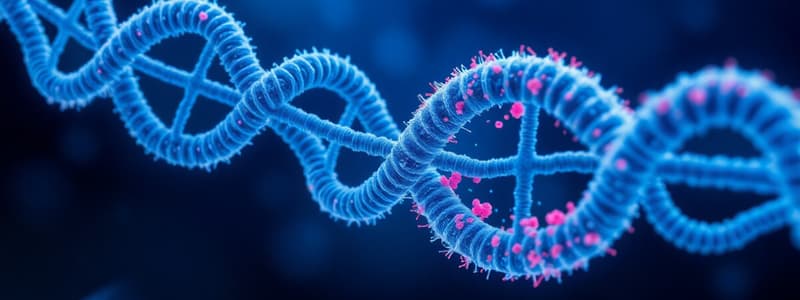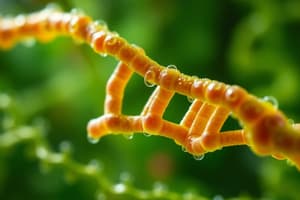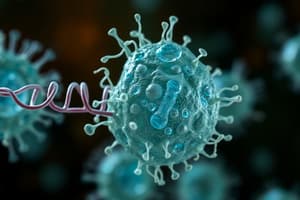Podcast
Questions and Answers
What differentiates eukaryotic genes from prokaryotic genes?
What differentiates eukaryotic genes from prokaryotic genes?
- Eukaryotic genes are typically split by introns. (correct)
- Eukaryotic genes are exclusively polycistronic.
- Eukaryotic genes lack open reading frames.
- Eukaryotic genes do not require transcription.
What is necessary for a eukaryotic gene transcript to be expressed?
What is necessary for a eukaryotic gene transcript to be expressed?
- The presence of exons alone.
- Coupling of transcription and translation.
- Removal of introns from the transcript. (correct)
- The gene being located in the cytoplasm.
Which statement about prokaryotic gene expression is accurate?
Which statement about prokaryotic gene expression is accurate?
- Transcription and translation are uncoupled.
- It occurs in the nucleus.
- It often involves polycistronic mRNA. (correct)
- Introns must be removed before translation.
What is the role of introns in eukaryotic genes?
What is the role of introns in eukaryotic genes?
Which of the following best describes the central dogma of molecular biology?
Which of the following best describes the central dogma of molecular biology?
What is the purpose of transporting eukaryotic mRNA out of the nucleus?
What is the purpose of transporting eukaryotic mRNA out of the nucleus?
Which statement about eukaryotic mRNA processing is correct?
Which statement about eukaryotic mRNA processing is correct?
What feature is NOT typically found in eukaryotic gene structure?
What feature is NOT typically found in eukaryotic gene structure?
Which of the following correctly describes the TATA box in the core promoter?
Which of the following correctly describes the TATA box in the core promoter?
What role do proteins like cap-binding protein and poly-A-binding protein serve during mRNA export?
What role do proteins like cap-binding protein and poly-A-binding protein serve during mRNA export?
What is the correct sequence of events described by the central dogma of molecular biology?
What is the correct sequence of events described by the central dogma of molecular biology?
Which characteristic is true for gene expression in prokaryotes compared to eukaryotes?
Which characteristic is true for gene expression in prokaryotes compared to eukaryotes?
What is the primary function of intron removal in gene expression?
What is the primary function of intron removal in gene expression?
What type of mRNA will be produced when an operon is transcribed in bacteria?
What type of mRNA will be produced when an operon is transcribed in bacteria?
Why is the organization of genes in operons considered efficient for bacterial cells?
Why is the organization of genes in operons considered efficient for bacterial cells?
What nucleotides are present in the RNA molecule during transcription?
What nucleotides are present in the RNA molecule during transcription?
What is likely the consequence of alternative splicing in eukaryotic gene expression?
What is likely the consequence of alternative splicing in eukaryotic gene expression?
Which of the following statements about DNA replication and transcription is true?
Which of the following statements about DNA replication and transcription is true?
What is the primary function of snRNA in the context of gene expression?
What is the primary function of snRNA in the context of gene expression?
How do promoter elements differ between simple single-celled eukaryotes and multicellular organisms?
How do promoter elements differ between simple single-celled eukaryotes and multicellular organisms?
What is the result of alternative splicing in eukaryotic genes?
What is the result of alternative splicing in eukaryotic genes?
Which molecules are primarily involved in the excising of introns in eukaryotes?
Which molecules are primarily involved in the excising of introns in eukaryotes?
Transcription of all eukaryotic protein-coding genes involves which of the following?
Transcription of all eukaryotic protein-coding genes involves which of the following?
In the context of gene expression, which aspect of multicellular organisms is highlighted?
In the context of gene expression, which aspect of multicellular organisms is highlighted?
Which of the following statements about introns and exons is true?
Which of the following statements about introns and exons is true?
What is a key feature of ribosomal gene transcription in eukaryotes?
What is a key feature of ribosomal gene transcription in eukaryotes?
What is the main protein mentioned that is to be cloned and expressed in E.coli?
What is the main protein mentioned that is to be cloned and expressed in E.coli?
Which method is necessary to avoid issues with splicing when preparing for polymerase chain reaction?
Which method is necessary to avoid issues with splicing when preparing for polymerase chain reaction?
What type of information can be accessed through ENSEMBL regarding genes?
What type of information can be accessed through ENSEMBL regarding genes?
Why is it not possible to use genomic DNA for the specific aims outlined?
Why is it not possible to use genomic DNA for the specific aims outlined?
What is the primary goal of the practical exercise mentioned for Week 2?
What is the primary goal of the practical exercise mentioned for Week 2?
Flashcards
mRNA (Messenger RNA)
mRNA (Messenger RNA)
A single-stranded molecule that carries genetic information from DNA to ribosomes for protein synthesis.
Transcription
Transcription
The process of creating a copy of a gene from DNA into RNA.
Translation
Translation
The process of translating the genetic code in mRNA into a sequence of amino acids to build a protein.
Operon
Operon
Signup and view all the flashcards
Polycistronic mRNA
Polycistronic mRNA
Signup and view all the flashcards
Gene Regulation
Gene Regulation
Signup and view all the flashcards
Intron Removal
Intron Removal
Signup and view all the flashcards
Alternative Splicing
Alternative Splicing
Signup and view all the flashcards
Open Reading Frame (ORF)
Open Reading Frame (ORF)
Signup and view all the flashcards
Introns
Introns
Signup and view all the flashcards
Intron Removal (Splicing)
Intron Removal (Splicing)
Signup and view all the flashcards
Coupled Transcription and Translation
Coupled Transcription and Translation
Signup and view all the flashcards
mRNA
mRNA
Signup and view all the flashcards
RNAP in snRNA genes
RNAP in snRNA genes
Signup and view all the flashcards
Upstream Promoter Elements
Upstream Promoter Elements
Signup and view all the flashcards
Transcription of ribosomal genes
Transcription of ribosomal genes
Signup and view all the flashcards
Transcription of eukaryotic protein-coding genes
Transcription of eukaryotic protein-coding genes
Signup and view all the flashcards
RNAP III transcription
RNAP III transcription
Signup and view all the flashcards
Promoter Complexity
Promoter Complexity
Signup and view all the flashcards
Study Notes
Gene Structure and Expression
- Genes in eukaryotes are more complex than in prokaryotes.
- Eukaryotic genes are composed of exons (coding regions) and introns (non-coding regions).
- Introns must be removed from primary transcripts to produce mature mRNA before translation
- Prokaryotic genes are often arranged in operons, allowing multiple genes to be transcribed together into a single polycistronic mRNA.
- This is efficient for prokaryotes since all genes involved in synthesizing a particular molecule can all be synthesized together.
- Eukaryotic gene expression is uncoupled, requiring mRNA processing and transport to the cytoplasm before translation.
- Eukaryotic mRNAs are modified (capped and polyadenylated) for stability and to aid transport from the nucleus.
- Eukaryotic mRNA transcripts are monocistronic, translating only one gene at a time.
- Prokaryotic organisms do not have a nucleus so transcription and translation occur simultaneously within the cytoplasm.
Central Dogma
- The central dogma describes the flow of genetic information, from DNA to RNA to protein.
- DNA is transcribed into RNA, and RNA is translated into protein.
- DNA replication copies DNA to ensure that genetic information can be passed on to new cells.
- In prokaryotes, this process occurs in the cytoplasm.
- In eukaryotes, transcription occurs in the nucleus, and the resulting mRNA is then exported to the cytoplasm for translation.
Eukaryotic mRNA Processing
- Eukaryotic pre-mRNA undergoes processing steps to become mature mRNA.
- Processing steps include splicing, 5' capping, and 3' polyadenylation.
- Splicing removes introns from the pre-mRNA.
- The 5' cap is added to the beginning of the mRNA.
- The 3' poly(A) tail is added to the end of the mRNA.
- mRNA export to cytoplasm needs to occur before translation.
Alternative Splicing
- Alternative splicing produces different proteins from a single gene, enabling multiple proteins with different functions to arise from a single gene.
- This involves different combinations of exons from a gene being joined together to form different mature mRNA transcripts, which will ultimately translate to different proteins
Core Promoter Elements
- Core promoters are conserved sequences in eukaryotes.
- They help recruit RNA polymerase to initiate transcription.
- Examples of these sequences include the TATA box, Initiator (Inr), Downstream Promoter Element (DPE), and GC box.
Upstream Promoter Elements
- Upstream promoter elements are sequences further upstream of the core promoter.
- They enhance or suppress gene transcription by interacting with other proteins and with RNA polymerase.
- These elements are more complex in eukaryotes compared to prokaryotes.
Practical Implications
- Learning outcomes included understanding transcription and translation in prokaryotes and eukaryotes, and how this relates to practical applications such as cloning.
- The aim of a given practical may involve amplifying, cloning, sequencing, and expressing a specific protein (e.g., MLF1) in E. coli.
Studying That Suits You
Use AI to generate personalized quizzes and flashcards to suit your learning preferences.




